Short answer:
Total daily energy expenditure (TDEE) calculators are designed to provide, at best, a rough estimate of your total daily energy expenditure, but the estimates they generate are routinely off by several hundred calories. So, if you’ve been diligently logging your weight and nutrition in MacroFactor for at least 3 weeks, it’s very likely that the TDEE calculator simply provided you with a poor estimate of your energy expenditure.
Conversely, if you’re a new user, and your initial expenditure estimate in MacroFactor differs from the output of a TDEE calculator, that just means MacroFactor uses a slightly different formula than the TDEE calculator you used. You can always enter a manual initial expenditure estimate if you think MacroFactor’s initial estimate is too high or too low, but simply logging your weight and nutrition will allow MacroFactor to converge on an accurate estimate of your energy expenditure, even if the initial estimate is inaccurate.
Longer answer:
Online TDEE calculators estimate your total daily energy expenditure using validated equations from the research literature. With these equations or calculators, you generally enter basic demographic and anthropometric information (age, sex, weight, and potentially body fat percentage), and the equation or calculator uses that information to estimate your basal metabolic rate (BMR). Most online calculators also ask you to rate your activity levels (sedentary, lightly active, moderately active, or highly active); this generates an activity multiplier. Finally, the calculator multiplies your estimated basal metabolic rate by the activity multiplier corresponding to your activity level, in order to estimate your total daily energy expenditure. From there, you might use this estimate of your energy expenditure to generate calorie targets for the purpose of gaining, losing, or maintaining weight. So, if one of these equations or calculators estimates that you’re burning 3000 calories per day, you could aim to consume 2500 calories per day to lose weight, 3200 calories per day to gain weight, or 3000 calories per day to maintain weight.
Overall, this is a pretty solid method of generating initial calorie targets, but it’s still a method with the potential for producing inappropriate calorie targets for a lot of folks, and it comes with pitfalls when you’re attempting to gain or lose a substantial amount of weight.
To start with, equation-derived estimates of basal metabolic rate necessarily have some degree of estimation error. Two people with the same age, sex, weight, and body composition can have different basal metabolic rates, so no equation can perfectly predict your basal metabolic rate. So, how large are the errors?
A 2018 study assessed the accuracy of 26 different research-validated equations for estimating basal metabolic rate. The researchers found that the typical error produced by these equations was ~150-400 calories per day (depending on the equation being used and the population being studied). Furthermore, these equations generated predictions that differed from the subjects’ measured basal metabolic rates by less than 10% for ~5-80% of subjects (again, depending on the equation being used and the population being studied). It’s also worth noting that individual errors can be much larger than typical errors. In other words, an equation with a typical error of 200 calories doesn’t generate a 200-calorie error for every individual – it could produce no error for one individual, and a 400-calorie error for another individual.

Figure A: Percentage of estimates with errors smaller than 5% (black) and 10% (white) for each equation. Figure B: Absolute differences between actual RMR and estimated RMR (mean ± SD) for each equation. These figures evaluate the accuracy of RMR estimation equations for overweight individuals; similar figures for normal-weight individuals and individuals with obesity are also available in the original paper. From Amaro-Gahete et al (2018).
However, this is a relatively decent picture overall. Most of the equations have prediction errors of smaller than 10% for most people. They’re certainly not guaranteed to perfectly estimate your basal metabolic rate – even under the most optimistic scenario, these equations have an estimation error of exceeding 10% for ~20% of people – but they generate a decent ballpark estimate for most folks.
However, that’s just step 1. Step 2 is where things get a bit dicier: multiplying your estimated basal metabolic rate by some activity factor in order to estimate your total daily energy expenditure.
The table below shows the most common set of activity multipliers:
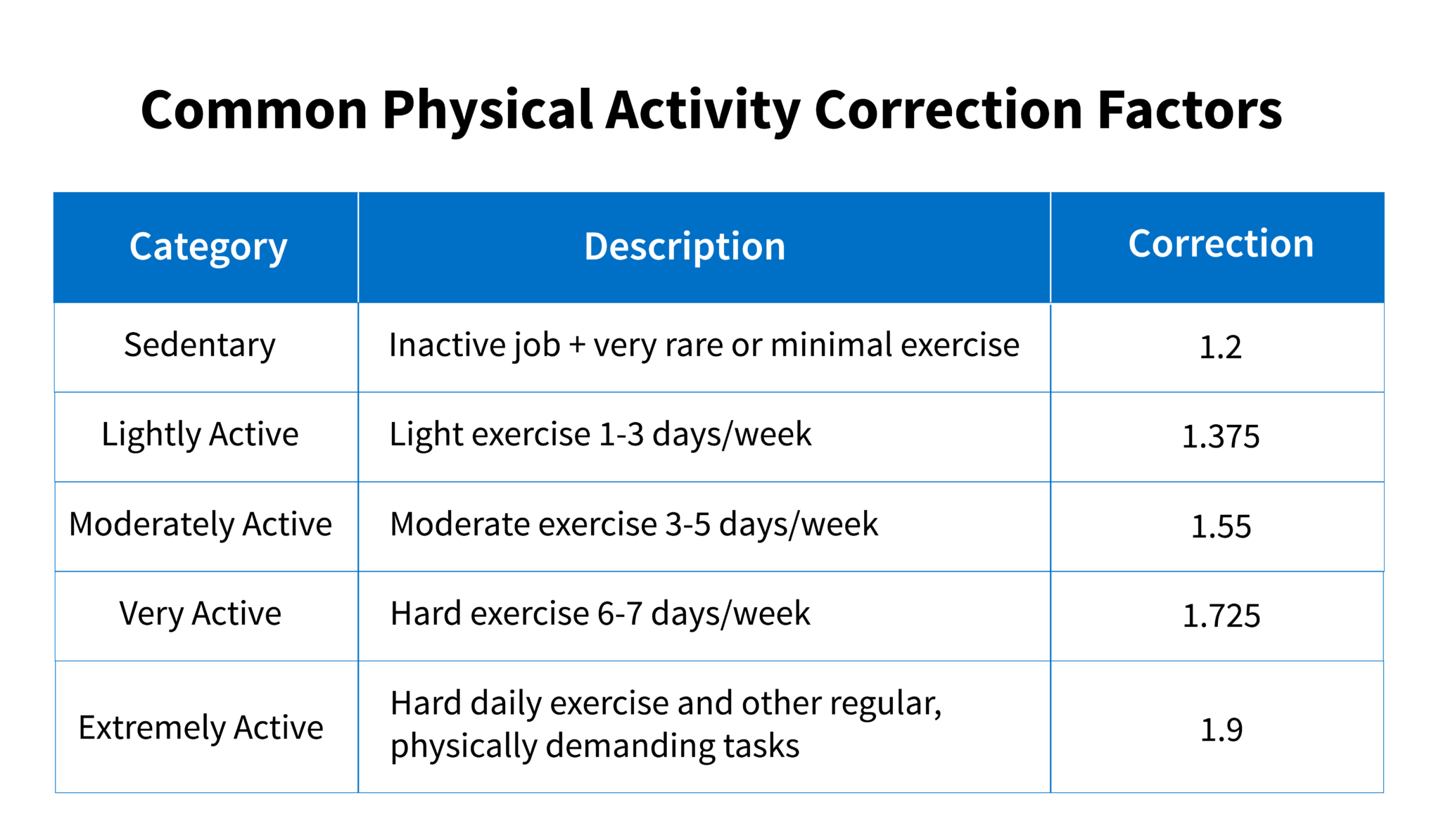
Right away, we can see one potential source of error: misclassifying your activity level. How do you know whether you’re sedentary or lightly active? Or moderately active versus very active? Most calculators and resources don’t provide a ton of guidance to help you select the appropriate activity multiplier, and most don’t distinguish between dedicated exercise and other forms of activity (i.e. having a physically demanding job, or walking/biking to get around).
Looking at these category descriptions, you see indicators of non-exercise physical activity (“regular physically demanding tasks” or “inactive job”), exercise difficulty (light, moderate, or hard, which appears to be a combined metric representing intensity and duration), and exercise frequency (in days per week). However, there’s no clear way to isolate these independent elements and sum them to obtain a cumulative value, and there are several combinations of these variables that aren’t explicitly represented in the table.
For example, hard exercise is paired with an assumption of high frequency (6-7 days/week), and light exercise is paired with an assumption of low frequency (1-3 days per week). It’s also implied that someone with a generally sedentary lifestyle (outside of exercise) does minimal exercise, and that someone with a high degree of non-exercise physical activity also does a lot of structured exercise. In short, the common physical activity correction factors are quite ambiguous and difficult to objectively classify.
So, even if an equation perfectly predicted your BMR, choosing the wrong activity multiplier would mean misestimating your total daily energy expenditure by 10-15%.
Furthermore, since activity multipliers are discrete “buckets,” simply falling in between two multipliers can generate error. For example, let’s assume your total daily energy expenditure is 1.62-times your basal metabolic rate. The “moderately active” multiplier is 1.55 (4.3% lower than would be ideal), and the “very active” multiplier is 1.725 (6.1% higher than would be ideal). So, even if an equation estimated your basal metabolic rate with an error of less than 10%, the addition of activity multipliers might still mean that your estimated total daily energy expenditure is misestimated by ~15%. For most people, total daily energy expenditure is somewhere between 1.1-2.2 times higher than basal metabolic rate – within this range, the average error generated by this “bucketing” of activity factors means that estimations of total daily energy expenditure will have errors that are 4.2% larger than equation-derived estimates of basal metabolic rate even if everyone chooses the correct activity multiplier.
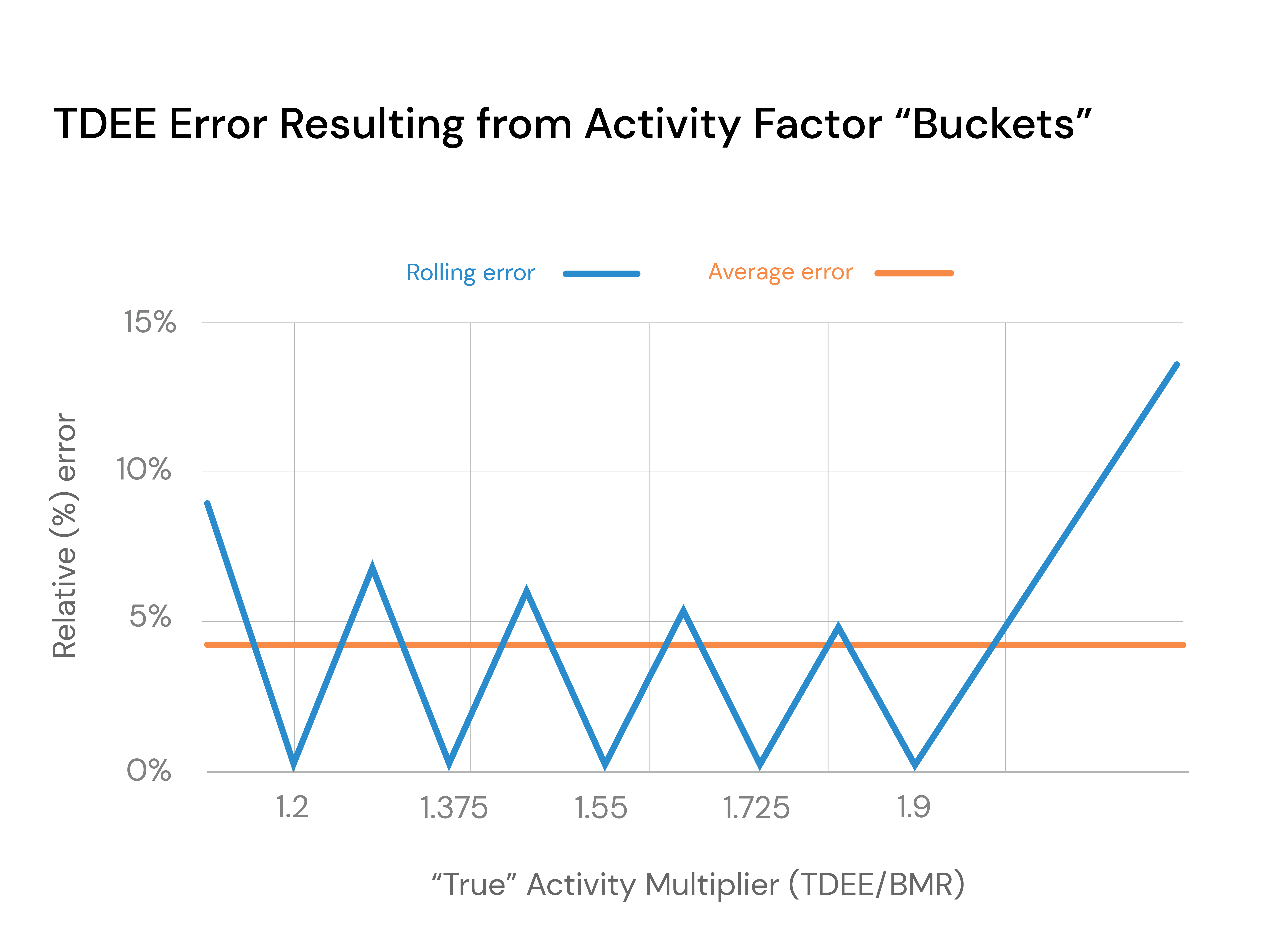
The blue line indicates the error introduced by the “bucketing” of activity multipliers, even if everyone selects the appropriate activity multiplier. For example, if your TDEE is approximately 1.3-times your BMR, you’re not particularly close to the “sedentary” multiplier (1.2), or the “lightly active” multiplier (1.375), so selecting either multiplier would increase the error of your BMR estimate by ~5%. The orange line indicates the average error introduced by this bucketing across the typical range of activity levels.
So, using equations or online calculators to estimate your total daily energy expenditure clearly comes with some degree of error, but how large are the typical errors generated by this method?
As far as I’m aware, there isn’t any research that directly examines this question. However, we can model it easily enough.
First, we need to estimate the typical distribution of actual basal metabolic rates. A study by Mifflin-St Jeor study, which was used to create one of the most popular BMR equations, found that the BMR distribution of ~500 subjects had a mean of 1564 calories, with a standard deviation of 336 calories. That seems like a reasonable starting point. So, I first generated ~3000 “subjects” with basal metabolic rates following a normal distribution with these characteristics.
From there, we need to generate a realistic set of estimated basal metabolic rates. Since the typical error of BMR equations is ~200 calories per day, I added a random integer to the set of “true” basal metabolic rates, with a mean of 0 and a standard deviation of 250 calories. That produces a set of “estimates” with the same mean as the set of “true” basal metabolic rates, where the average “estimate” differs from its corresponding “true” value by an average of about 200 calories. You can see the distribution of “true” and “estimated” BMRs in the figure below.
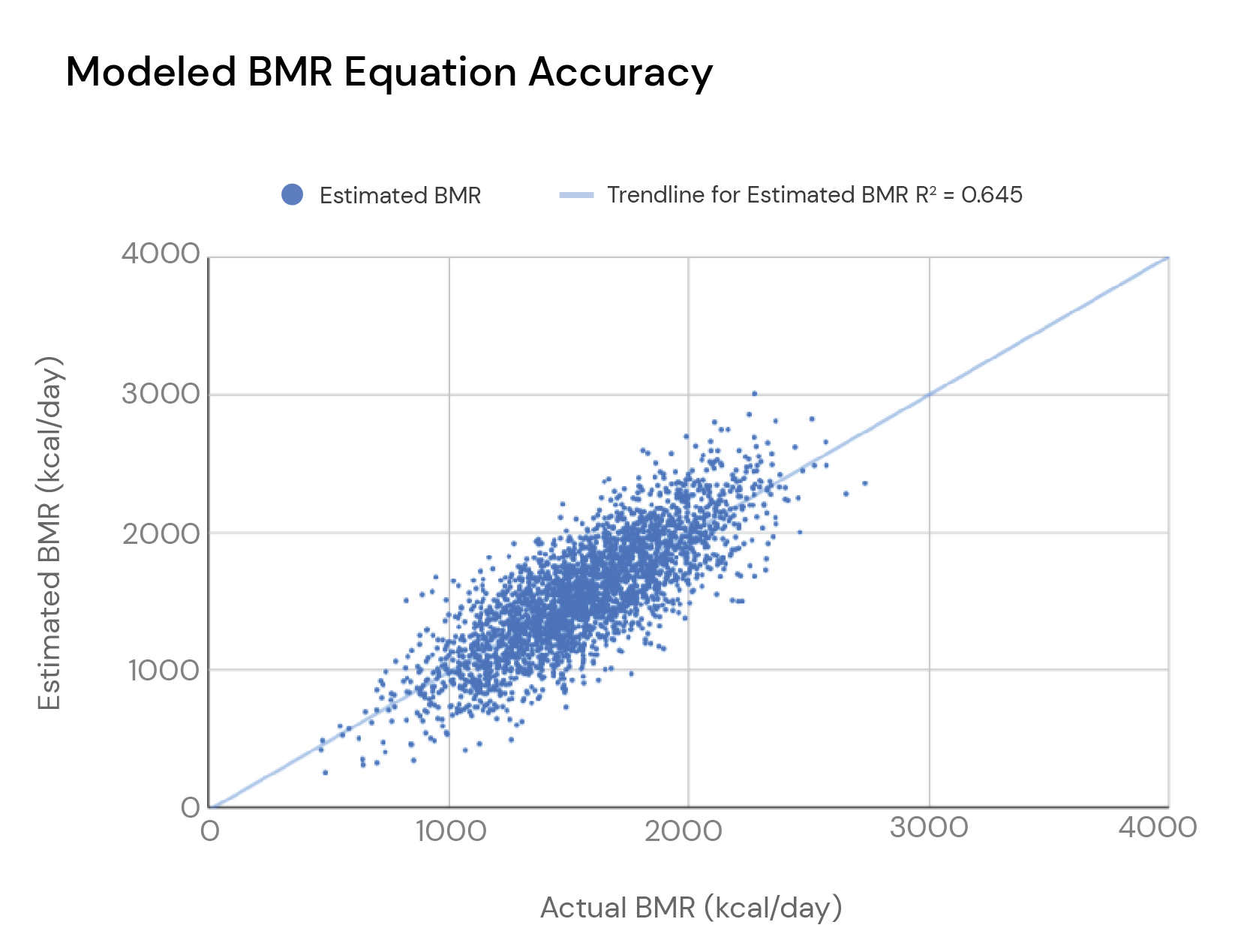
If you’d like to see similar plots using real human data, see Figure 1 here. You’ll see that the strength of the correlation and the general characteristics of the data match up well with this synthetic dataset.
After that, we need to multiply these BMR values by activity factors to estimate total daily energy expenditures. For the “true” BMR values, I multiplied them by a normally distributed set of activity factors, with a mean of 1.55 and a standard deviation of 0.2 (meaning that the largest chunk of people are “moderately active,” with a pretty fair number of “very active” and “lightly active” folks, and a smaller number of “sedentary” and “extremely active” folks). For the “estimated” BMR values, I charitably assumed that all people would select the correct bucketed activity multiplier; for example, every person with a “true” activity multiplier closest to the “moderately active” multiplier of 1.55 would correctly rate themselves as moderately active, every person with a “true” activity multiplier closest to the “sedentary” multiplier of 1.2 would correctly rate themselves as sedentary, etc.
After this step, we have a set of “true” total daily energy expenditures, and a corresponding set of estimated total daily energy expenditures. You can see the distribution of “true” and “estimated” TDEEs in the figure below.
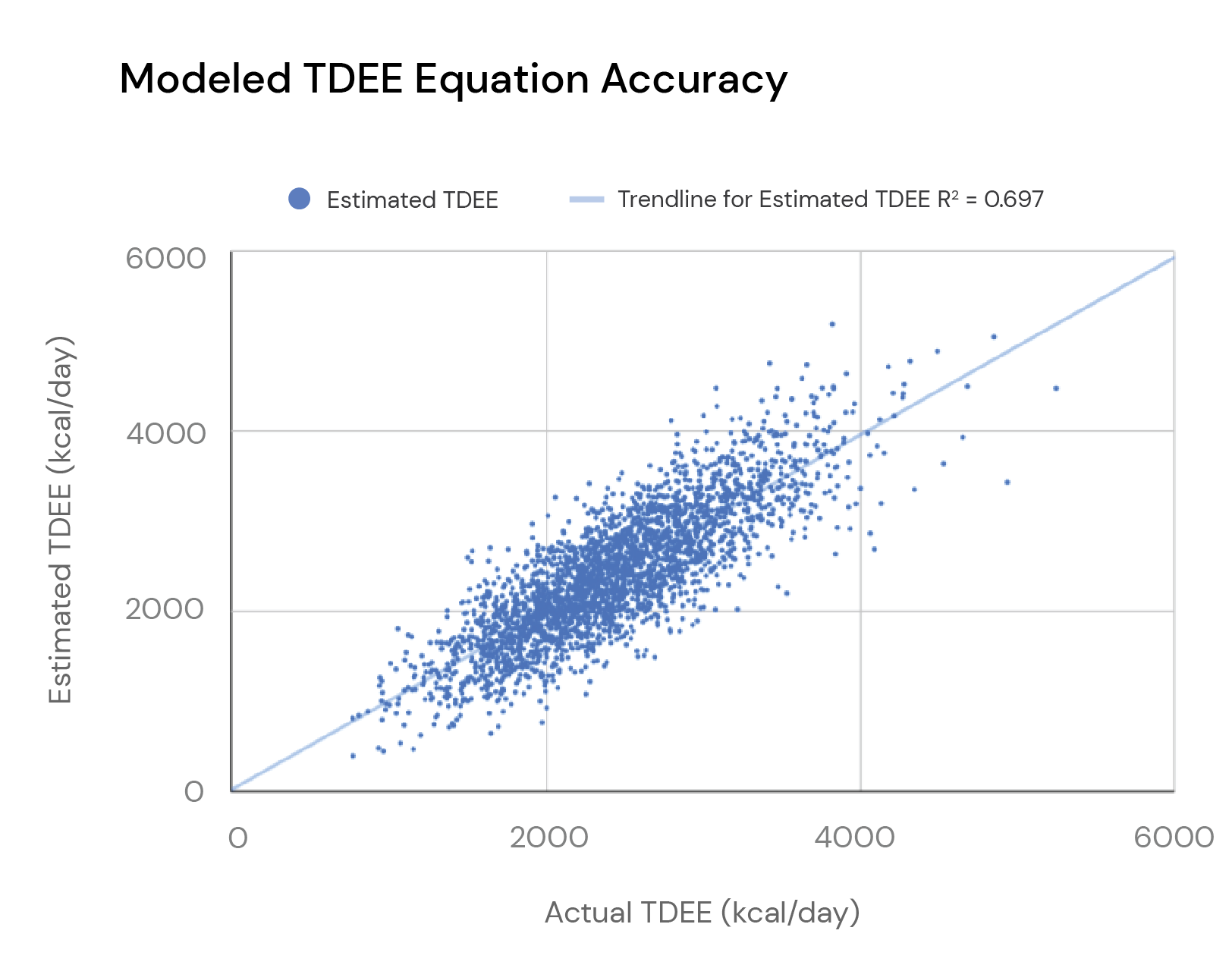
The table below summarizes these results:
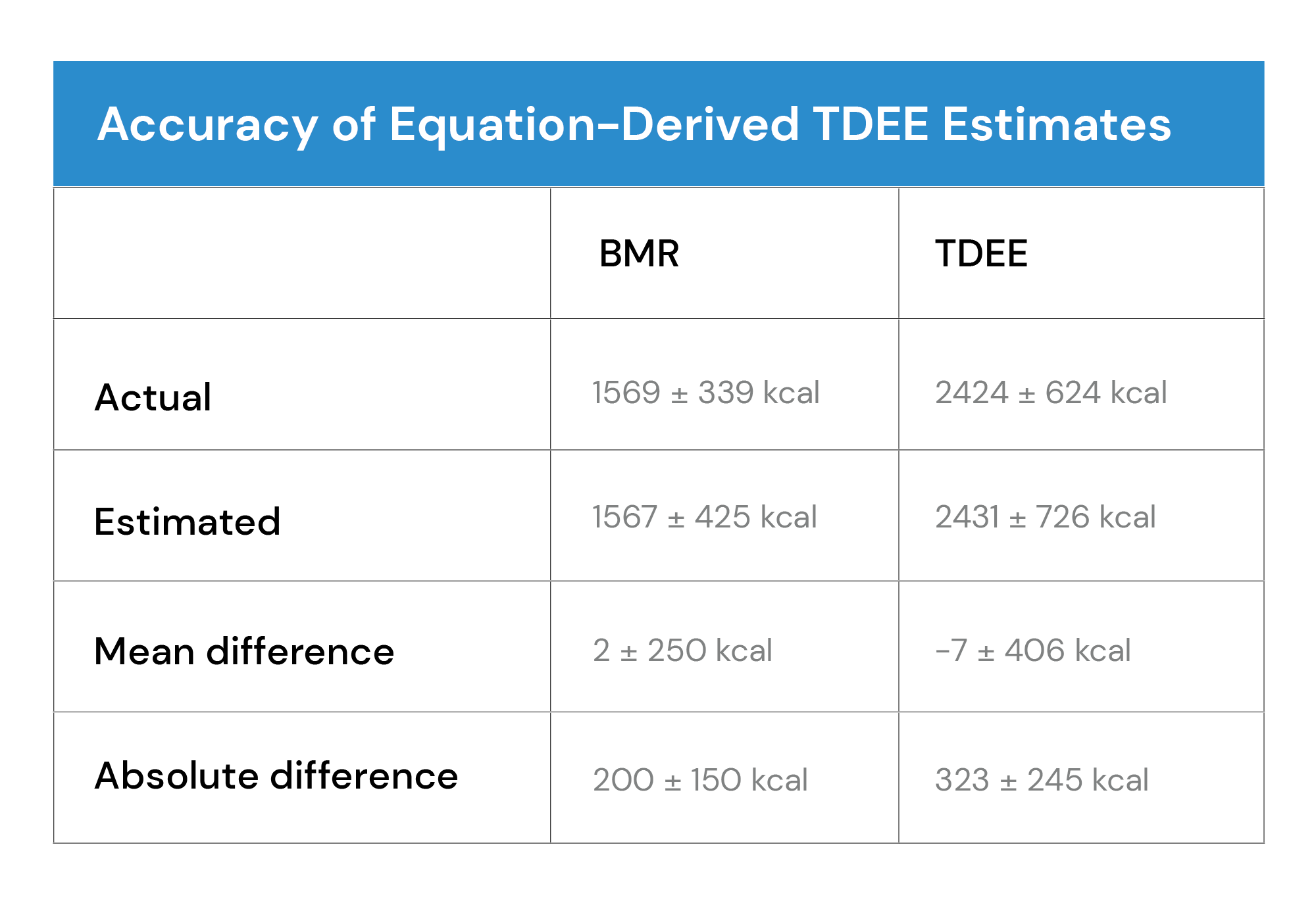
So, the average prediction error is about 325 calories/day, but that doesn’t mean that all individual errors will be exactly 325 calories/day, and it certainly doesn’t mean that individual errors can’t exceed 325 calories/day. The graph below shows the distribution of individual TDEE prediction errors you can expect when using a TDEE calculator:
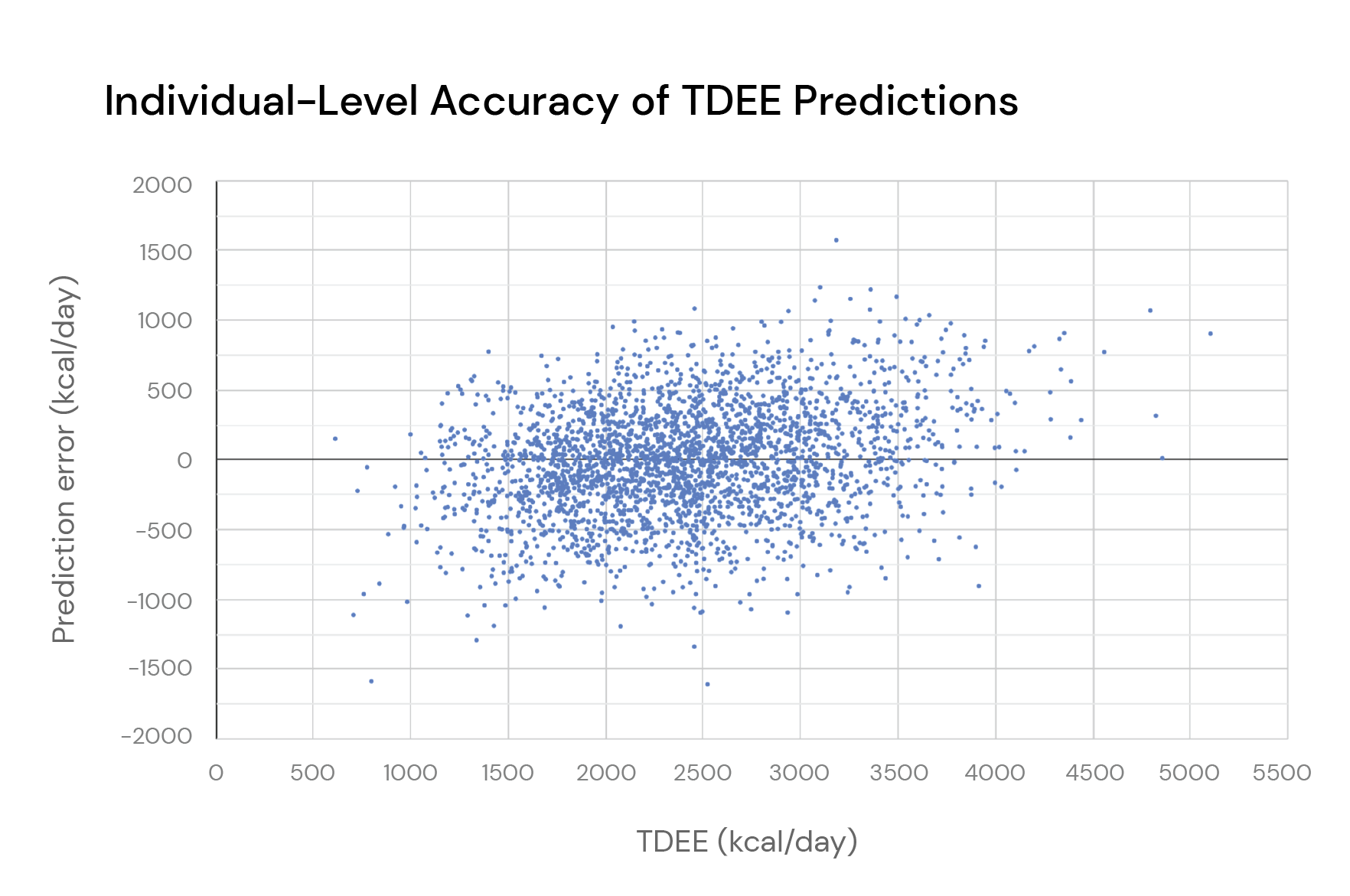
When we break it down, relatively few people (~20%) will get really accurate calorie recommendations from this process (errors smaller than 100 calories). Furthermore, a decent chunk of people (almost 30%) will get reasonably accurate calorie recommendations for their goals (errors between 100 and 250 calories). So, a little under 50% of people will get recommendations that meet my personal definition of “close enough.” In other words, if these folks wanted to lose a pound per week, this process would generate calorie targets consistent with losing somewhere between 0.5-1.5lbs per week for nearly 50% of individuals.
However, the largest group of people (a little over 30%) will have errors between 250-500 calories/day. Errors of this magnitude still put you in the right general ballpark, but they can start having a meaningful negative impact on your goals. For instance, if someone tried to generate calorie targets to lose half a pound per week, and their TDEE was overestimated by 300 calories/day, they could wind up in a small energy surplus. The same principle would apply if someone was aiming to gain weight gradually, but their TDEE was underestimated by 300 calories/day (i.e., they’d wind up in a small energy deficit, instead of a small surplus).
Moving on, about 20% of people will get recommendations with errors between 500-1000 calories/day. So, if a TDEE calculator tells you that you’re burning 2500 calories/day, there’s about a 20% chance that you’re actually burning between 1500-2000 calories/day, or 3000-3500 calories/day. Finally, 1.5-2% of people will get errors exceeding 1000 calories/day, resulting in really, really bad recommendations.

So, using a TDEE estimation equation or calculator results in a pretty solid expenditure estimate a bit less than half the time, and an expenditure estimate that’s at least within the right general ballpark (errors <500 calories/day) nearly 80% of the time. However, it also results in reasonably large errors (>250 calories/day) at least half of the time, and pretty inappropriate recommendations (errors >500 calories/day) more than 20% of the time. And keep in mind, when modeling this, I assumed that everyone would select the correct activity multiplier when converting their BMR estimate into a TDEE estimate, which is an implausibly generous assumption. In the real world, since some percentage of people will select the wrong activity multiplier, the actual accuracy of TDEE calculators is even worse.
Of note, MacroFactor also uses a validated BMR prediction equation for your initial expenditure estimate. So, if your estimated expenditure on day 1 differs from the output of an online TDEE calculator, the differing estimates are just the result of using slightly different equations. If you prefer another TDEE calculator’s output to MacroFactor’s initial expenditure estimate, you can always enter a manual initial expenditure.
From there, MacroFactor’s algorithms generate a more refined and individualized estimate of your expenditure based on your weight and nutrition data. So, if you’ve been diligently logging your weight and nutrition in MacroFactor for at least 3-4 weeks, and your expenditure in MacroFactor is significantly different from the output of a TDEE calculator, the most likely explanation is that the TDEE calculator generated an inaccurate estimate of your energy expenditure.
Finally, if you think MacroFactor’s expenditure estimate is wrong, you can always test it for yourself. For instance, an online calculator may tell you that your TDEE is 2500 calories/day, while MacroFactor thinks your expenditure is 2000 calories/day. If you’re trying to lose a pound per week (which requires an energy deficit of about 500 calories/day), and you think the TDEE calculator is producing a more accurate estimate of your energy expenditure, try eating 2000 calories/day for a while. If you do end up losing a pound per week, your estimated expenditure in MacroFactor will increase to match your expectations. If you don’t end up losing weight, that would strongly suggest that MacroFactor is estimating your energy needs far more accurately than the TDEE calculator.
Now that you understand why the MacroFactor expenditure is different than other TDEE calculators, you might enjoy one of these articles next:
What Should I Do if My Initial Expenditure or Recommended Energy Intake Seems Too High or Too Low?
What Should I Do If My Activity Levels Change Drastically?